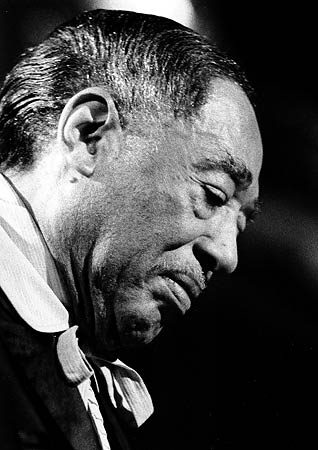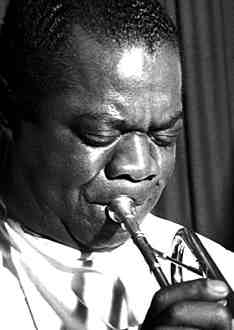THE LOST LANGUAGE OF JAZZ
IN AN ON-LINE
AGE
by WAYNE BREMSER
Wayne
Bremser produces
harlem.org, a web site on the history of jazz.
This article originally appeared in
Newsday.
* * * * * * * * * *
Jazz
is one of the most complex forms of modern art, yet it remains
accessible to millions of listeners. Fans don't need university
courses to dissect the magic of jazz; we've been educated by
our own music collections.
The
older among us remember that wonderful dinosaur, the long-playing
record, which came with a trove of information to help a listener
better understand the music. In the days before MTV, record
labels made the album an immersing experience with striking
graphic design, moody photographs, and informative liner notes
written by prominent critics such as Stanley Crouch, Amiri Baraka,
Dan Morgenstern, and Ralph J. Gleason.
In
the age of the CD, the large graphics and photos have shrunk
considerably, but we have gained better sound quality and exhaustive
boxed sets that still include essays and detailed performance
notes as well as alternative takes of favorite tracks that were
cut from the original LPs.
With
all of this written and recorded information accessible in one
package, it is easier than ever to track a jazz musician's ideas
and techniques evolving day by day, session by session, which
is how the art form advances.
Appreciating
this, our ears are not so startled when the smooth Miles Davis
of Kind of Blue produces the menacing Bitches Brew
of 10 years later. Understanding this progression, we can make
some sense of Ornette Coleman's listener-unfriendly Free
Jazz the first time we hear it.
 For
the players, this same information has been the doorway to the
past -- the primary source for studying who played what, when
and with whom.
For
the players, this same information has been the doorway to the
past -- the primary source for studying who played what, when
and with whom.
How
long this tradition of jazz education will continue is in serious
doubt, however, with the growing popularity of digital music
online. Young people are no longer tethered to albums or discs.
They are downloading a large portion of their music illegally
and purchasing the rest of it from digital music stores like
Apple Computer's popular iTunes Music Store, which has sold
more than 100 million songs.
Online
music has great potential for musicians and students of jazz.
Imagine typing Night and Day into your computer and listening
to dozens of versions of the song. Or accessing Duke Ellington's
entire catalogue with a few mouse clicks rather than driving
around town searching record stores. That's the good news for
jazz. The bad news is almost everything else.
Millions
of young listeners are buying music that is sold without liner
notes, correct recording dates, and session information. Even
the musicians' names are often removed from their performances.
 That's
the state of the art at iTunes. Search for one of my favorite
albums, Coleman Hawkins Encounters Ben Webster. You'll
see that iTunes lists the release date of this 1957 session
as 1997 (the date the CD was released). Curious about who plays
bass? Good luck, iTunes won't tell you. (It was Ray Brown.)
That's
the state of the art at iTunes. Search for one of my favorite
albums, Coleman Hawkins Encounters Ben Webster. You'll
see that iTunes lists the release date of this 1957 session
as 1997 (the date the CD was released). Curious about who plays
bass? Good luck, iTunes won't tell you. (It was Ray Brown.)
In
the liner notes, Ben Webster is interviewed by the legendary
critic Nat Hentoff. Webster explains the influence of Coleman
Hawkins: "I dug his big tone and that drive, to me he was
saying more than anybody else on his horn. . . . There are times
when he'll play what's in vogue for three or four choruses and
then, on top of that, he'll play something he's been doing for
a long time." The CD version includes further reminiscences
by Hentoff, written four decades after the original notes.
You
won't find any of this information on iTunes or the other online
music stores.
Another
drawback is that the typical digital music file is but a fraction
of CD sound quality. It's like comparing a jug wine that you
might drink at a beach party to a glass of good Merlot that
you want to smell, taste, and savor. If this seems like the
audiophile snobbery of a jazz fan, download Jimi Hendrix's Little
Wing from Walmart.com. To me, his guitar solo sounds as if it
was recorded underwater in a swimming pool.
Which
is a reminder that thousands of songs scattered out of context
with virtually no identifying information are a threat to the
growth of all forms of music, from folk to rock to pop to bluegrass
to classical. There's no way to find out the names of the conductor
or orchestra on certain classical compilations sold online,
let alone the names of the soloists. A new fan might be curious
about who sings and plays guitar with Eric Clapton on his most
famous album, Layla and Other Assorted Love Songs.
It's impossible to learn this through iTunes.
 The
less that contemporary players in all genres know about the
past, the less likely they will be to advance the music. But
jazz is perhaps at the greatest risk for two reasons: Listeners
require at least a small level of explanation to approach it,
and improvisation is at the core of its DNA.
The
less that contemporary players in all genres know about the
past, the less likely they will be to advance the music. But
jazz is perhaps at the greatest risk for two reasons: Listeners
require at least a small level of explanation to approach it,
and improvisation is at the core of its DNA.
Composition
in jazz occurs session by session, club by club, date by date,
player by player. In turn, the players need an educated audience
that will encourage them to keep pushing the limits. Knowledgeable
fans who are enthusiastic about jazz's possibilities can support
a musician's ability to innovate.
Already
there is a growing audience for jazz that's accessible rather
than challenging. We have seen the popularity in recent years
of cookie-cutter ‘smooth’ and ‘quiet storm’
jazz radio stations offering a soothing background tapestry
to daily activities with a program of music that doesn't engage
the audience in any kind of dialogue.
Will
a listener schooled on this music, whose source for more diverse
jazz recordings is an online music store, be receptive to the
intensity of a performance by Ornette Coleman or Sonny Rollins
that might touch a much wider range of emotions? Or by someone
new who is inspired by these players?
A great
work of art can be enjoyed without explanation or context, but
nobody would claim to truly understand Cubism by glancing at
a few paintings or try to explain Fellini by watching just one
film. Appreciating jazz means listening to the work of a large
network of players who developed a musical language together
across decades of recording sessions.
 It's
impossible to study the great mid-1950s recordings of Miles
Davis without knowing who John Coltrane is. And it's hard to
appreciate the accomplishments of Coltrane without understanding
the influence of Charlie Parker, who fashioned bebop along with
Dizzy Gillespie, who in turn was influenced by Roy Eldridge,
who followed in Louis Armstrong's footsteps by playing with
the Fletcher Henderson band in the mid-1930s. It's the proverbial
great chain.
It's
impossible to study the great mid-1950s recordings of Miles
Davis without knowing who John Coltrane is. And it's hard to
appreciate the accomplishments of Coltrane without understanding
the influence of Charlie Parker, who fashioned bebop along with
Dizzy Gillespie, who in turn was influenced by Roy Eldridge,
who followed in Louis Armstrong's footsteps by playing with
the Fletcher Henderson band in the mid-1930s. It's the proverbial
great chain.
Just
as you can be a baseball fan without memorizing statistics,
it's not essential that listeners or players learn every detail
of jazz's great genealogy of influences and ideas. But to become
a fan and certainly to pass the most basic stage as a musician,
you need at least some familiarity with the lineage.
The
best hope for the future of jazz is that the online music stores
will add features in the next generation of software. The information
that has been removed from jazz albums can still be replaced.
But consumers probably will have to demand it first.
We
live in a time when many listeners don't care who plays bass
on a Jay-Z track or which 1970s funk band was sampled on a Beyonce
single. The culture of music videos leaves a large number of
musicians unseen and anonymous.
While
the market might not demand more information about music right
now, companies such as Apple, Sony, Wal-Mart, and Napster, which
have worked closely with the music industry to build their online
stores, need to remember that tastes will change, people grow
up, and someday listeners and musicians might want to know more
about what exactly they are listening to.
In
the case of jazz, the future of improvisation really depends
on it. Leaving this information out for a generation is the
first step toward losing it forever.